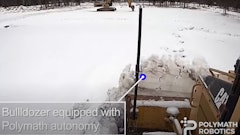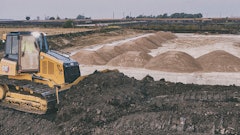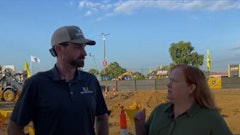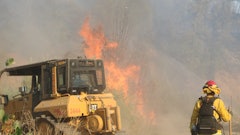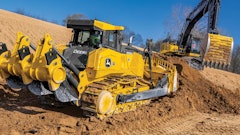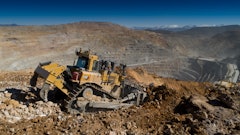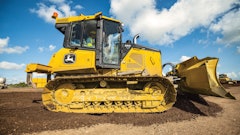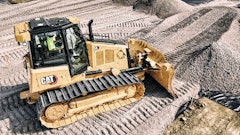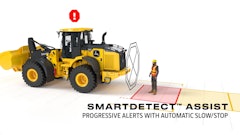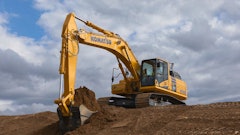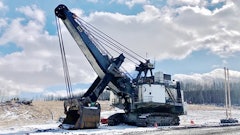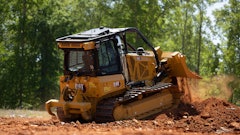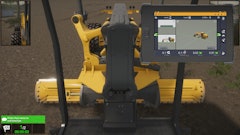While the cost and importance associated with the crawler tractors on a jobsite usually necessitate a companys best and most talented operators, even seasoned veterans can benefit from professional operator training. In many cases, operator training presents the largest single opportunity for improvements in productivity and reductions in operating costs, says James Kell, manager of the Productivity Management Group, Empire Caterpillar, a regional dealer covering Arizona and part of Southern California and the Baja Peninsula.
This is true of both new and experienced equipment users. Take those who participate in Caterpillars Certified Operator training program. Many have been operating for 20 or 30 years and they may think they know it all, says Brian Sims, senior product demonstrator/instructor, Edwards Demonstration Center, Caterpillar. Thirty years of doing it one way doesnt mean they have been doing it the most efficiently. During each class, everybody learns something... For some it may be a refresher, while others hear our message for the first time. Either way, they learn something they didnt know or had forgotten.
Self-taught operators can realize immediate improvements through structured training. They can definitely develop bad habits when they are not taught correctly, says Sims. A lot of times, they just dont know there is a better way of doing something until we tell and show them. Not only does training help with proficiency, it can increase an operators satisfaction with the job and help them achieve their goals with less effort and fatigue by doing the job correctly the first time.
Of course, even veteran operators need to keep up with machine advancements. Machines are always evolving with new and innovative features, says Gary Svoboda, manager of field training, Komatsu America Corp. Operators who do not understand why a modern machine acts differently or responds the way it does may not be utilizing beneficial features or operational techniques.
Also, the operator who has the initiative to learn can continuously improve existing skills, he adds, or develop new techniques to be safer, more efficient and productive.
Purpose of
pre-training
There are various self-paced training tools available online or on CD that can allow operators to gain the basics (e.g., maintenance, inspection and operation).
For example, VISTA Training Inc.s computer-based training (CBT) programs allow self-learning based around the operators schedule. Operators get at least the basics, so when they go to a machine they spend less time and less fuel, and there is less risk of damage, says Rick Longstaff, president.
Caterpillar Equipment Training Solutions (ETS) includes self-learning training CDs for operators, technicians, equipment owners and others who want to learn the operating basics. These materials are intended to give end users a basic knowledge of safety, maintenance, pre-operating procedures and operating procedures. There is a self-check exercise at the end of each unit, and a final examination at the end of the program that enables students to print their results.
People are using more classroom and CBT pre-training than they have in the past, Longstaff comments. It allows contractors to make sure an operator already knows key operating concepts before he or she gets on the machine. This helps make on-the-machine operator training time more efficient because it has been augmented by a structured program.
Pre-training also minimizes the amount of time a machine has to be taken out of service. When we send our pre-training CBT out to the contractor, they take advantage of having an operators attention, making sure they are learning the right things as they are moving through, Longstaff points out. By the time our instructors arrive on site, the operators have a solid base, so they are not wasting valuable machine time.
Svoboda adds, The days are gone of strictly on-the-job training. The cost of the machines, more complex features and controls and the need to be more efficient have made it more important that operators receive uninterrupted training to understand and get the full benefit of all information presented.
Elements of structured training
Operator training is available through most local equipment dealers. For example, Empire Caterpillar offers four different training levels, depending upon the experience of the operators and the goals of the customer. We can also develop custom courses to address very specific production or maintenance issues, says Kell.
To assess individual training needs, Empire Caterpillar can perform (and recommends) a site survey. The site survey allows us to produce a cost/benefit analysis prior to scheduling training courses. It also allows us to target the proper level of training and prioritize the courses based on value to the customer, Kell explains.
In most cases, training is then conducted on the customers site using their equipment. However, Empire Caterpillar has also constructed a training site in Eloy, AZ, to assist customers who are unable to have training conducted at their location.
Most operators can benefit from high-quality operator training, Kell asserts. Equipment technology is rapidly changing, new techniques are developed to make use of that technology and few operators have attended formal operator training.
Structured training programs can be tailored to the needs of a particular set of operators.
We offer a structured program that can be done at one of our learning centers or on the jobsite, says Sims. The key benefits are that the operators are learning the most efficient and safest methods of operation, with the ability for our instructors to demonstrate what we teach.
The training provided typically depends on current operator skill level. Komatsu offers different levels of training, but requires students to have experience and qualifications by industry standards on similar types of equipment, says Svoboda.
Likewise, Caterpillar prefers to train operators with a core skill set. We offer all levels of training, from someone who has never been on the machine all the way through really experienced operators who want to be recognized for their skills, says Sims. We prefer the Level II class ? the operator who has experience. Let us spend some time with him and make him a better operator.
The length and content of the training is based on operator experience. But we never leave without teaching them how to move material with the machine, says Sims. With experienced operators, Level II and up, the goal is to teach them a lot more about technique.
We typically target our classes for four to six operators and we spend two and a half days with them, he says. We provide classroom instruction, walk-around inspections and hands-on training and demonstration. We use our training curriculum, PowerPoints and videos, and the use of a simulator is in the near future.
The class can be tailored to meet the unique needs of a specific contractor, including instruction on the latest technologies. Through the Connected Worksite Group, we offer training on all of the AccuGrade equipment, including GPS, laser, Universal Total Station (UTS) and CAES, Sims indicates.
Caterpillar starts its classes with a written safety test, on which all operators are required to score 100%. They are then given a written knowledge test, which requires a score of at least 80%. Next, operators proceed to physical tests on the machine. If they pass the course, they are certified. If an individual didnt meet the standard, we tell them what they need to work on in order to pass the next time they take the test. They take a period of time and practice, and we get a lot of return people, says Sims.
VISTA starts its training programs by sending its trainers to the jobsite to observe operators firsthand. We will evaluate their skill, then we will train them in the classroom, says Longstaff. The instructors then take them out to the machines and coach them in operation. VISTA trains operators at all skill levels, but the training for less skilled operators will take longer.
Evaluating results
At the end of training, VISTA carefully evaluates the operators performance. We will rate the operators on their deficiencies ? where they need to improve, says Longstaff. This is a critical step in creating a plan for further improvements.
VISTA also polls all of its students after they have completed the training, many of whom already have 20 years of experience under their belts. Almost everyone says, I have been doing this for a long time and I still learned something, Longstaff states.
While the results of the training are immediate, they can be a little hard to quantify; assigning values to their true benefits can be difficult. We actually get quite a bit of feedback, says Sims. In Marion, IL, we received a call back from a customer that claimed they had a 15% to 18% improvement in production after a four-day visit.
The largest gains come in the form of improvements in production. They are not working harder, they are working smarter, Sims emphasizes. Actually, at the end of the day, they can be more relaxed because we show them the right way [to accomplish the task]. Instead of fighting the machine, we teach them to make the machine do what it was designed to do. If they are more comfortable in the cab, they will move more material at the end of the shift than they did before.







